
Via Veloce by Wille R. www.veloce.se since November 1995 and still here.
Alfa Romeo Duetto 1966 -
1969 FAQ
--![]()
Headlamp cowls
Headlamp cowls by Carello made in Perflex. Popular design like Ferrari and Jaguar E-type. Alfa continued until the mid '70s with this arrangement in Europe. The 1750 Veloce had the same cowls in Europe. Today, they are hard to find so in case you see a pair, buy them
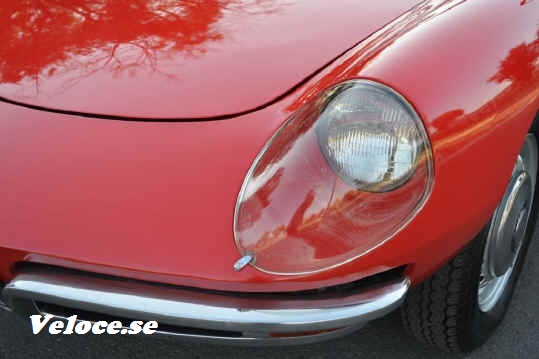
In the early part of this century, all cars had headlights with a
replaceable bulb. These worked for awhile but the bulbs would quickly
darken with age. In the 1930's, someone (I believe General Electric) came
up with a "sealed beam" headlight. The best way to describe it
is that the entire headlight is the bulb. The filament is sealed inside
the headlight. These sealed beam headlights were state of the art in the
1930's. They were brighter and did not darken like the headlights which
used bulbs. Shortly thereafter, the US government required that all new
cars sold in the US be equipped with sealed beam headlights.
There was a stamped Carello mark at the centre of the cowl. Aftermarket reproductions are missing the stamp for some reason. D means Destra, right side. S means Sinistra, left side
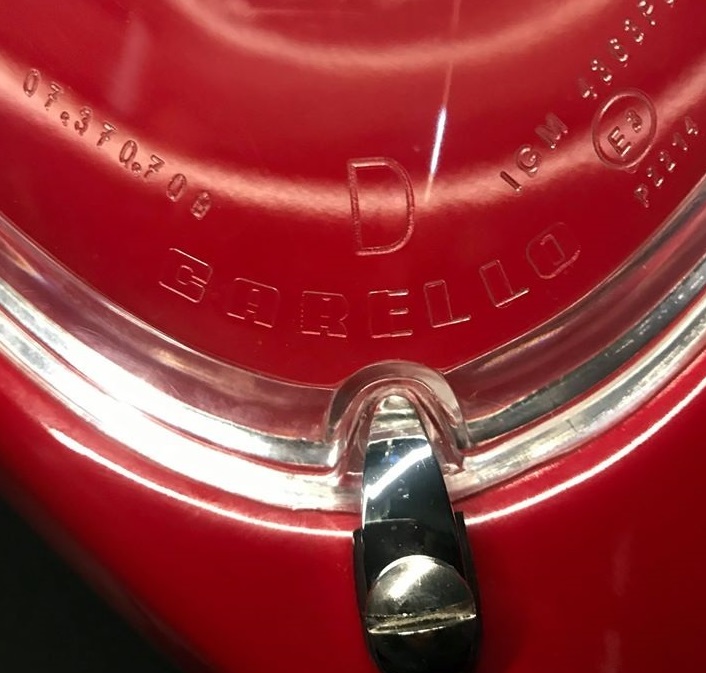
Like all technology, however, the sealed beam became out of date. By the
1950's the quartz iodine and quartz halogen bulbs were developed. Of
course, these bulbs were much brighter than the sealed beam headlights and
did not darken. Everyone went to these type of headlights except the US
where the out of date regulations prohibited their use.
You should note that these regulations also prohibited the use of any type
of headlight cover. Thus, none of the US Alfa Spiders came equipped with
headlight covers. Alas, only the lucky Europeans were treated to the
beautiful headlight covers on the Duetto.
In the late 1970's some of the headlight manufacturers incorporated a
quartz halogen bulb in the sealed beam headlights. This was an improvement
but was nowhere as good as the H4 headlights used in Europe. By 1985, the
regulators finally figured out that the sealed beam headlight was
hopelessly out of date, and allowed bulb type headlights. However, the
type of bulb and wattage was severely limited. It is only within the last
two years that H4 bulbs have been allowed in the US, but the regulations
still only allow a maximum of 65 watts on the high beam.
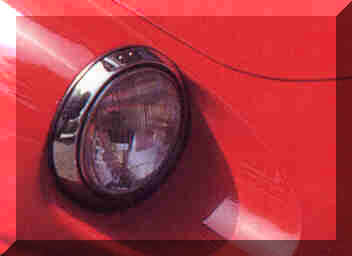
The sealed beam headlights look almost identical to the H4 round 7 inch headlights. They are also interchangeable, that is the mounts are identical. The sealed beam headlights just do not perform as well.
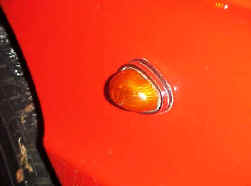
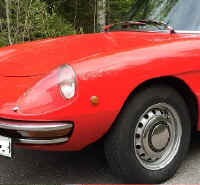
Teardrop shaped side repeaters looked nice. The left photo shows the teardrop. If the fender has been changed and repaired, it is likely to have the indicator at the front of the wheel. Late 1750 Veloce Euro cars had the indicator in front like this, so did the US 1750 cars too. It's an easy way to see if a 1600 Duetto has been repaired.
The euro cars do
have a different frame inside the wing (fender) which allows the headlight
bowl to mount from behind. It then has a very thin stainless steel
finisher which mounts around the wing aperture. The headlamp itself is
held in place with a chrome retaining ring. The US cars had a larger
chrome finishing trim & the headlights were mounted from the front. I
am sure you can fit the Carello Perspex's without changing the headlight
but you may need to modify the large chrome ring a little at the top.
Car not destined for the US/NA market headlights mounted inside the
fender. Bulbs were changed from inside the fender, as was beam adjstment.
The edge of the hole in sheet metal is trimmed with a simple aluminum
extruded ring, aprox 1/4" in section diameter. Some of these cars
found they way here one way or another, but were not sold by Englewood
here.
US spec cars had a completely different installation in order to meet
DOT lighting requirements. One of the stipulations was that the beams must
be adjustable using no more than a screwdriver, without the aid of a lift,
etc. which completely shot down the standard system. And of course, the
covers were absolutely out of the question. I was party to a series of
email exchanges with Don Black, who was in charge of bringing the vehicle
into compliance in 1966, and he was quite adamant that the covers were
never installed on any US spec car from the factory, and that the parts to
install the covers were supposed to be removed before the vehicle was
sold, though anecdotal evidence suggest that this wasn't always done.
Which brings around to the the matter of the "mystery" trim
rings. A variety of trim ring exists which will cover the US style
headlight bucket guts while still allowing the the covers to be fitted.
While not exactly ubiquitous the rings are common enough that for years
many of us assumed that this was an Alfa part and it came with the car.
Not so, according to Don. It sounds like these are the rings you have from
the '69.
The flush mounted, euro headlight buckets are not interchangeable with
the US buckets, and that's why you can't figure out how to mount them. It
can be done, but you need modify and adapt to make it work.
Your options are:
Purchase a complete set of headlight fairings with all the mounting.
To install remove the headlight buckets from the front and reinstall
them from the rear of the fender (inside the wheel well). All the holes
are there and the parts fit.
If you have any comments, please send an E-mail
#